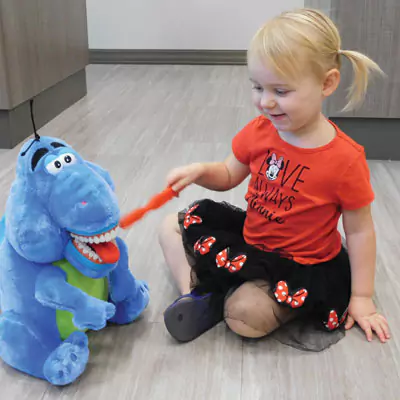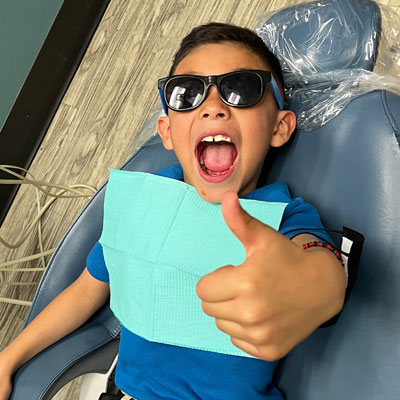
PRE AND POST-OP INSTRUCTIONS
General Anesthesia
Before Your Child's Appointment
Instructions to Have a Successful Dental Appointment with Office-Based General Anesthesia
Why in-office General Anesthesia?
At times, a child may not be able to tolerate dental treatment while awake or with conscious sedation. This may be due to their young age, fear, anxiety, or an extensive amount of treatment needs. For these patients, the child’s dentist may recommend using general anesthesia. With modern anesthesia delivery and monitoring equipment, we can create a safe and convenient surgery center setting for dental sedation here in our office. By providing the procedure in the office, your child is going to a place they are already familiar with. This can help ease fear and anxiousness. It also helps the parent avoid the inconvenience and expense of a hospital visit. Although parents are not allowed to stay with the child while they are under general anesthesia, your child will be under the direct supervision and monitored by the anesthesiologist throughout the entire procedure.
During the general anesthesia procedure, we are not able to permit parents/guardians to be in the treatment area. Family members will be asked to wait in the lobby during the procedure. Upon completion of treatment, you will be escorted to the recovery area where you can be with your child during their recovery from anesthesia and until they meet the anesthesiologists discharge criteria. You are encouraged to speak with your child's anesthesiologist and ask any questions you have regarding your child's care.
The steps below are designed to help you prepare for your child’s general anesthesia appointment. Ensure to follow all instructions the Anesthesiologist and Anesthesia Team provides for your child’s safety. Please advise of any changes to your child’s medical history or medications before your anesthesia appointment. Please reach out anytime with questions or concerns. We are happy to discuss your child’s oral health care with you in more detail.
- Prepare. No School or Daycare before or after their appointment. Your child needs to remain in your constant supervision before their general anesthesia appointment.
Please know that every child’s dental needs are different. We try to schedule the appointment lengths as accurately as possible; however, sometimes, we cannot predict how much treatment the child will need until sedated. Please keep in mind that we are giving each child the best care possible. Please have at least a 3-hour window to be here at our office. Please also designate the remainder of the day to supervise your child or to have a responsible adult supervise your child once you arrive home.
Our General Anesthesia Coordinator will contact you within 48 hours before the date of surgery to go over more details for this appointment. If you have any questions or concerns, please contact us.
- NPO "Nothing By Mouth." Please ensure to follow the Anesthesiologist’s instructions for fasting. Fasting is also referred to as ‘NPO’ or nothing by mouth. For your child's safety, their stomach must be empty for general anesthesia. Food or drink in the stomach can be vomited and aspirated into the lungs, putting your child's safety at risk. If your child takes morning medications, let us know before the date of your child’s appointment so that we can discuss with the Anesthesiologist and determine appropriate steps.
*Plan ahead. Make sure your child has not hidden food or candy in his room. Make sure there are no snacks in the car. Warn siblings against feeding them. Do not take your child to daycare or school. Your child will need your supervision to ensure they have had nothing to eat or drink. This is an important safety measure.
- Appropriate Dress. Please dress your child in a short-sleeve shirt for the appointment. They may wear a jacket or coat over their shirt, but we will need short sleeves for the procedure. We suggest you remove any jewelry from your
child before the appointment. For younger children, you may wish to use a diaper or pull-up.
- Office Check-in. Once you are checked in for your appointment, our anesthesiologist will consult with you about your child’s medical history and any other pertinent information related to general anesthesia. The anesthesiologist
will listen to your child’s heart and lungs to ensure they are clear and that your child is healthy for the procedure. Please note: If your child becomes ill with a chest cold, cough or fever before the appointment, please inform the anesthesiologist.
It may be best to reschedule the procedure. Your child’s health and safety are our top priority.
- Anesthesia- How do we put a child under General Anesthesia? Once your child is cleared for general anesthesia, the anesthesiologist will walk the child back to the treatment room, where they will be administered an
anesthetic gas through a mask that will make them fall asleep. This could take up to 30 seconds. Once asleep from the gas, the anesthesiologist will place an intravenous (IV) line. Oxygen, breathing equipment, and standard operating room vital
sign monitors will also be used. When the child is fully sedated, our dentist will proceed to complete all the dental treatment your child may require. During this time, the parent must remain in the waiting area throughout the entire procedure
until the patient is ready for transfer to recovery.
- Recovery from General Anesthesia. Once your child’s dental treatment is completed, they will be moved to the recovery area. Once the patient is cleared, we will bring parents back to join us while your child starts to recover
from the anesthesia. You may notice red marks on their skin from medical tape or the anesthesia mask. These markings are temporary. There may be small amounts of blood in the mouth from the dental procedure. Most children feel tired, weak, and
moody as they wake up from general anesthesia. All these side effects will resolve with time. Please keep in mind that this could last anywhere from 15 minutes to several hours for some children. Before your child is released, we will discuss
and have you sign a discharge form. The discharge form includes the specific aftercare/homecare instructions that are discussed.
- Transport Home. We recommend that you follow state law regarding your child's car seat and seat belt. If possible, having another responsible adult care for the child in the back seat during the drive home can be helpful.
- Home Care. After the appointment, most children feel tired and may appear moody. Letting your child take a nap will allow them to sleep through most of these side effects. We recommend that you give your child clear liquids as tolerated
(e.g., water, apple juice, Gatorade). Once they ask for food, we recommend a small portion of soft food. Crackers, bread, applesauce, bananas, noodles, and soup are good examples. Meat and dairy should be avoided for the first few hours. (keep
in mind that your child may have some residual ‘numb’ feeling. Please ensure they are not biting, chewing, or sucking on their tongue, lips, or cheeks, as this can result in soft tissue injury.
At home, supervise your child closely and limit your child’s activities. Do not expect or allow your child to ride a bicycle or tricycle, swim, play on a swing-set, trampoline, or attempt other physical activities for the remainder of the day of the appointment. Resume normal physical activities the day after your appointment.
After Your Child's Appointment
Now that your child's General Anesthesia appointment is complete and they have met our discharge criteria:
- Activity. Please supervise your child closely for the remainder of the day. Your child may feel sleepy for several hours and nap on and off throughout the day. If your child sleeps, have them sleep on their side and be sure you can see them. Limit activities. Your child should NOT drive, ride a bike, swim, jump on trampolines, or do any other activity requiring full coordination for the remainder of the day. They can usually expect to resume normal activities on the day following their surgery.
- Fever. Your child may become flushed with a slight fever following the anesthesia and/or the extensive dental treatment. As your child recovers, they should be kept indoors in a cool place for the remainder of the day. Seek medical attention for excessive fever (over 103 degrees).
- Diet. Begin slowly with mild, clear liquids as tolerated (e.g., water, Gatorade). Gradually introduce more solid foods throughout the day. Avoid meat or dairy for 2-3 hours. The dentist may have additional dietary restrictions depending on the patient's procedure.
- Pain / Discomfort. It is not uncommon for patients to experience discomfort or pain following their dental procedure. The anesthesiologist may have administered IV pain medications during the surgery, but these generally wear off within a few hours after the procedure.
The dentist may have also administered local anesthesia (e.g., Lidocaine), so your child may be numb in parts of their mouth. If pain persists despite taking the recommended pain medications (as instructed before checking out), please contact the dentist.
- Nausea / Vomiting. Nausea and vomiting occasionally occur following anesthesia. During the procedure, your child was given anti-nausea medication in their IV. If your child becomes nauseated or vomits the following discharge, restrict them to clear liquids like soda until nausea passes.
If vomiting persists for longer than 4 hours, PLEASE CONTACT THE ANESTHESIOLOGIST. The office will provide you with this phone number before you leave.
- Bleeding. A small amount of bleeding is expected following many dental procedures. Please follow the dentist's instructions regarding post-operative bleeding. If bleeding persists longer than you were told to expect or seems excessive, contact the dentist. A small amount of bleeding from the nose may occur if a breathing tube is placed.
- Any Questions or Concerns. If you have any questions or concerns, please do not hesitate to call the office: (417) 469-7637.
- Emergency. 911, If you feel there is a true emergency, call 911.

